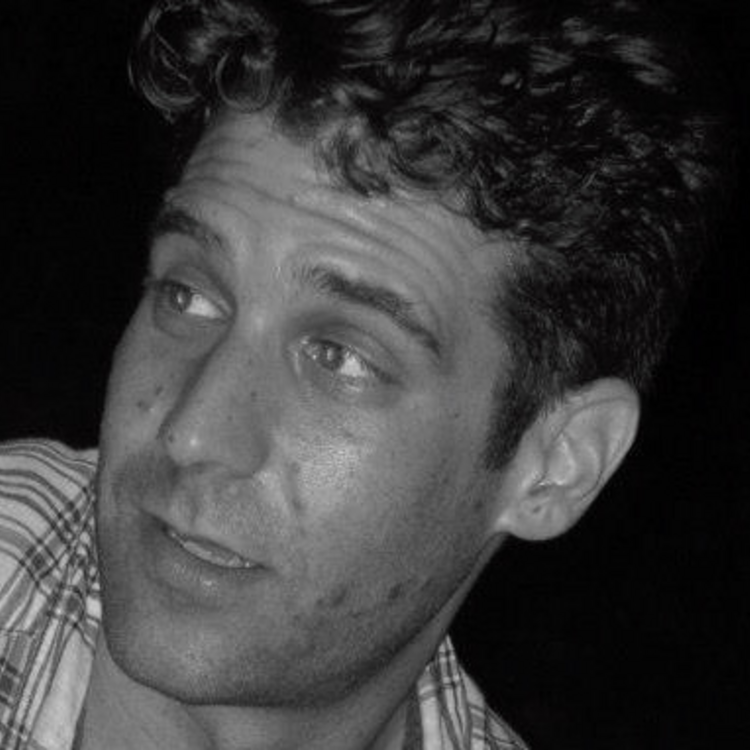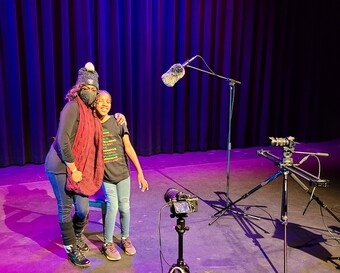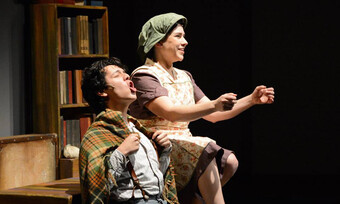Theater for Young Audiences, America, and the Two Plutos
Last year I attended the Berlin International Film Festival as producer of a film selected for their Generation Program. Generation is comprised of films chosen to include younger audiences in cinematic conversations on themes of death, joy, loss, love, disorder, and identity. The program is dedicated to engaging younger audience in how, not what, to feel, about topics that aren’t “child friendly” by modern American standards.
Unlike other festivals, the magnificent Berlinale is not solely for the industry, but for Berliners themselves. Every screening was full. Berlin comes out en masse. For Generation they bring their children and public schools schedule field trips.
I was fortunate to attend the Generation Premiere of the visually stunning and emotionally haunting film Pluto, about the misguided lengths to which students in Seoul will go to secure spots at the best universities. The 1000-seat theater was packed and included many German teenagers. During the talkback with the director, a teenage girl rose to speak. Her voice was jumpy. “I’m fifteen,” she quivered repeatedly. “I’m not sure how I should feel—I’m fifteen. The movie was amazing—but—I’m not sure I should have seen it. Why did you choose it for us?” The film had lodged itself under her skin and had opened within her an endless stream of emotions.
The programmer leading the talkback responded calmly. He told her he understood her confusion; in his thirties, he feels the same as she does. But he knows when the shock lessens, he will be able to consider his feelings, and perhaps formulate a greater understanding of the world through the lens of this story. And he hopes she will too. At this point the audience erupted in massive applause.
I should not be surprised. I agree as an artist, an educator, and a human being. And yet I could not fathom similar support in the United States. I’d like to think that provocative art for young audiences, theater in particular, would be as passionately received here, but I’m not sure. The Laramie Project has become a school-censored standard. Lesser known works that have shared a similar fate include: Tender Yellow Sky, a new play created for high school students in California which examined teen suicide; Higher Ground, a new play for middle school students in Portland focused on bullying, homophobia, and racism; and Columbinus at Lexington High School in Massachusetts. Each was cancelled due to concerns that the material was too suggestive, could lead to detrimental behavior, and was therefore inappropriate. How these topics are inappropriate for those they affect is beyond me.
I’m not suggesting we present nothing of substance for young audiences—in two of the three cases above, private theaters offered rescue—but it is not as firmly built into our educational establishments. This is a problem. In an unrelated Washington Post article, James Haughton, artistic director of New York’s Signature Theater, states, “access is education. If you can be in the room, that’s the beginning.” With a downward trend in school funding among the subjects deemed “necessary,” where does that leave the access to art as education that Haughton suggests? Examples abound in schools where only “child friendly” work (a demeaning term) is presented. But such control blocks the necessary personal education a child must have. Yes, this is changing; yes, a watershed in art/educational paradigms is gaining traction, but not fast enough.
I’d like to think that provocative art for young audiences, theater in particular, would be as passionately received here, but I’m not sure.
I have to wonder why Berliners are willing to bring their children to film or theater like Pluto. Why are they more apt to present for their children’s consideration an unvarnished exploration of what is dark and hard in the world, and Americans are not? For Berlin perhaps the answer lies in proximity and history: surrounded by empires, amidst shifting international borders, at the violent hub of two world wars, and viciously cleft by the Cold War. Theirs is a complex and bitter past that cannot be sugarcoated. Berliners do not try to do so. East Berlin has not replaced its drab buildings, rather in embracing their exteriors and renovating only the interior they allow the past to remain in order to shape the present and future. It’s recognition related to advancement. I see a similarity in what they present to their young audiences. The fact that they trust them enough to navigate their own emotions is a bonus.
I was fortunate to grow up in a stable home, with a private education, in an abundant art/museum/theater region. But still, looking back on my nineties childhood (the age of the after-school special) I can’t recall that the Theater for a Young Audience I saw took the risk to really trust my intellectual and emotional abilities. I know this too is changing. But the battle around “appropriateness” continues. This is not a bad conversation to have, but it is highly subjective, and those who might know best are often not included in that decision. They should at least be part of the conversation.
This brings me to the play Pluto by Steve Yockey, currently finishing its NNPN Rolling World Premiere at Orlando Shakespeare Theater. Though not necessarily intended, nor presented as such, I believe the play to be for audiences of all ages, most definitely including middle and high school students. It is an astounding piece, and creates a magnificent world of magic and heightened dramatic resonance on a difficult subject: school shootings. Besides asking its audience to comprehend the pain, loss, anger, and confusion suffered by the families and victims, it provokes the audience to consider the violent offenders themselves not simply as monsters. It grants empathy to all without apologizing for, or condoning, behavior. And it does not talk down to its audience. It sets a high intellectual, emotional, and theatrical bar. It trades in as much wonder as it does horror. It does not shy away from dark themes, surrealism, adult language, or suspenseful drama. It invites a conversation. It is a play for parents and teenagers. It is a play that should be seen and discussed in class and around the dinner table. It is a play that opens up the door to emotional awareness and exchange, two things that cannot be learned from a textbook. It is a play that teaches without didacticism, on a subject that young adults, sadly, know better than their elders.
This play challenges everyone, but most importantly the local theaters and school boards, who hold, in their hand, its ability to reach the youth of their communities. Much of America may feel safe, but we have our own brand of darkness to consider. By including young audiences in that dialogue we create avenues, through empathy, which help them grow up stronger, truly safer, and help us grow with them.
I can only hope that those who make the decision on what Theater for Young Audiences means will take on the awesome complexity of our American existence and present more works like Pluto. And I hope too, that more audiences around America will cheer for such a cause, as they did in Berlin.









Comments
The article is just the start of the conversation—we want to know what you think about this subject, too! HowlRound is a space for knowledge-sharing, and we welcome spirited, thoughtful, and on-topic dialogue. Find our full comments policy here
Good post. I've written a play about the confluence of segregation in the United States and the Holocaust. When it was produced, we brought in groups of high school students who study US History and World History in the 10th and 11th grades and they were very engaged. Yet I'm having difficulty finding ways to market this play for subsequent productions. The actors span three generations with the youngest character a 19-year-old college student and granddaughter of one of the main characters. The content is suitable for anyone over age 14. Yet where's the market? I'm exploring this.
Where to start?
First, let’s not conflate film with theatre. Movies – even challenging
documentaries – live in a different realm. None of us approach them the same
way, particularly young people or their guardians. On the one hand, take note that
the gatekeepers so respect the power and immediacy of theatre that they are
wary of its impact. On the other, please God, do not out me in another audience
of 8 year olds at the next Quentin Tarrantino movie I may choose to attend.
Next, where to start with comparing Germany and the United
States? We are different cultures with different histories. Public schools and other institutions in our country must negotiate compromises among dozens, if not hundreds of different communities. The conservative, protective winds blow from many directions, for many reasons.
Take a breath, please, before imagining that all young audiences are teenagers. There’s a tremendous amount of theatre being created for and by young people who are not yet teenagers. There’s work for children between the ages of 5 and 8. There’s an entire field of exploration for pre-school
children. Each of these audiences has different concerns and challenges.
Mainly, I urge you to take a look at what has been happening in professional TYA (Theatre for Young Audiences) in the United States. For the past 25 years or more, Suzan Zeder, Y York, Steven Dietz, Laurie Brooks, Jose Cruz Gonzalez and dozens of other serious American playwrights have been addressing issues such as homelessness, dispossession, death in the family, racism,
mental illness, imperialism, colonialism, & culture clash in deep, resonant and relevant
ways for children of all ages. Newer writers such as Arlene Hutton, Darrah
Cloud, John Yearly, and many others are “crossing over” to include work that addresses
the concerns of young people. William Mastrosimone’s 1999 play BANG BANG YOU’RE DEAD about school shootings has been performed over 15,000 times by students who have downloaded
the script for free. Theatres such as Seattle Children’s Theatre, People’s Light & Theatre, Honolulu Theatre for Youth, First Stage (Milwaukee), The Coterie (Kansas City), The Alliance
Theatre (Atlanta) , Metro (St. Louis), Dallas Children’s Theatre, The Children’s Theatre of Charlotte, Imagination stage (Bethesda), the Kennedy Center … (I could go on)… have aggressively sought out, commissioned, developed and produced hundreds of plays dealing with virtually every subject of interest and importance to young people while exploring a full range of theatrical styles and techniques.
I dare say that contemporary work for young people does a fuller and richer job of exploring the awesome complexity of our American existence than does most work for older people.
The challenge for this field is bridging the gap between it and the “adult theatre” world. It needs further professionalization; it needs writers who not only tackle “difficult” subject matter, but writers who respect their audience’s intelligence and who have the craft to write fully dramatic scripts.
It needs our best actors, our best directors, our best designers. This theatre for our best and most important audience. It should draw in our best artists and producers. It needs the resources to continue; it needs audiences who might just remember that childhood is a part of who they once
were. Indeed, good theatre for young people is theatre for “all ages.”
Finally, I think it might be time to stop equating "cutting edge" with darkness. The frontier of American Theatre lies in creating some positive options for the future. There a plethora of avenues to explore that do not involve serial killers, torture, or other sensationalist crimes. Television and other popular media are delving into that area with a vengeance. Serious, deep and thoughtful does not necessarily equal horrific.
Intrigued by the post and with Mark Lutwak's reply! I wanted to something along the lines of his mention of the "tremendous amount of theatre being created for and by young people who are not teenagers."
I'm reading this between school assemblies in which our actors are presenting new plays written by elementary school students (mostly 4th and 5th grade) at a residency that we conducted in the fall. In this work, young people find themselves presented with the challenges that the blog post mentions, but at the insistence of the individual person not the presenting organization. This is not to say that we shouldn't engage children in specific topics through theatre presentation - the comment above presents some playwrights whose work does exactly that - but rather a suggestion of an alternative approach.
Engaging young people in playwriting - any creative writing, really - engages students in the exploration of the themes, topics, and stories (and sometimes emotions) that pique their interest. In the last few years, when I see students (elementary and secondary) writing about many of the topics that challenge them, those topics reflect much of what the author of the post is suggesting. When students find themselves faced with the need to clarify characters, settings, and motivations within the world of the play they are creating, they are also asking questions of themselves and seeking out the answers in the development of the work.
Not to mention, engaging young people in the creation of their own work can meet each individual student on their own terms and sets them on their own path of discovery and enlightenment.